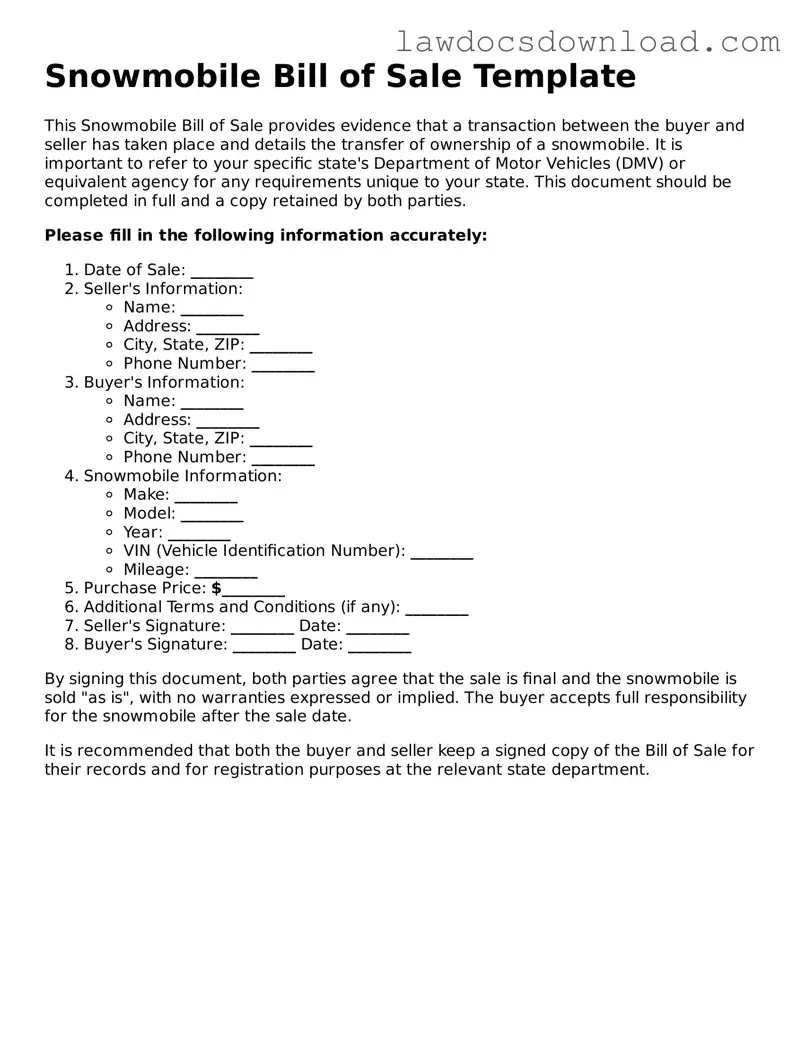The Vehicle Bill of Sale is very similar to the Snowmobile Bill of Sale, as both serve as legal proof of the sale and purchase of a vehicle. They detail the transaction between buyer and seller, including specifics about the vehicle, sale price, and date. These documents also often require notarization to verify the signatures of the parties involved.
A Boat Bill of Sale closely mirrors the Snowmobile Bill of Sale in purpose and content, acting as a record of the sale of a watercraft. It includes details such as the make, model, year, and Hull Identification Number (HIN), along with the sale price and the names of the buyer and seller, providing a legal record that the transaction took place.
The Motorcycle Bill of Sale is akin to the Snowmobile Bill of Sale, offering proof of purchase for a motorcycle. It contains information about the motorcycle, such as its description, VIN (Vehicle Identification Number), and mileage, in addition to the sale price and the particulars of the buyer and seller, ensuring a clear transfer of ownership.
A Trailer Bill of Sale shares similarities with the Snowmobile Bill of Sale, documenting the sale of a trailer. It includes details about the trailer, including its type, identification number, and make, alongside the transaction details. This document helps both parties by clearly stating the terms of the sale, providing legal evidence of the agreement.
An Equipment Bill of Sale is comparable to the Snowmobile Bill of Sale, but it focuses on the sale of equipment rather than vehicles. It records the specifics of the equipment sold, including type, model, and serial number, and details about the sale transaction, such as price and date, to formalize the change of ownership.
The Firearm Bill of Sale is another document similar to the Snowmobile Bill of Sale, specifically used for the sale of a gun. It includes critical details like the make, model, caliber, and serial number of the firearm, as well as information about the buyer and seller. This document is important for ensuring compliance with local and federal laws during the transfer of ownership.
An Animal Bill of Sale documents the sale of livestock or pets, similar to how the Snowmobile Bill of Sale records the sale of a snowmobile. This document includes details about the animal, such as breed, age, and health information, and records the terms of the sale to safeguard the interests of both parties.
A Business Bill of Sale, while concerned with the transfer of ownership of a business rather than a vehicle, parallels the Snowmobile Bill of Sale in structure and purpose. It outlines the specifics of the transaction, listing the assets being sold, the sale price, and the parties involved, ensuring a legally binding transfer of business ownership.
Real Estate Sale Contracts, though more comprehensive and complex, share the core intent of the Snowmobile Bill of Sale: to record a transaction. These contracts detail the sale of property, including price, terms, and conditions, and the identities of the buyer and seller, serving as a critical document in the transfer of real estate ownership.
Lastly, a General Bill of Sale serves a broad purpose similar to the Snowmobile Bill of Sale, used for selling and buying various items. It specifies the item being sold, the sale price, and the parties' details. Although more generic, it plays a crucial role in providing documented evidence of a wide range of personal property sales.
